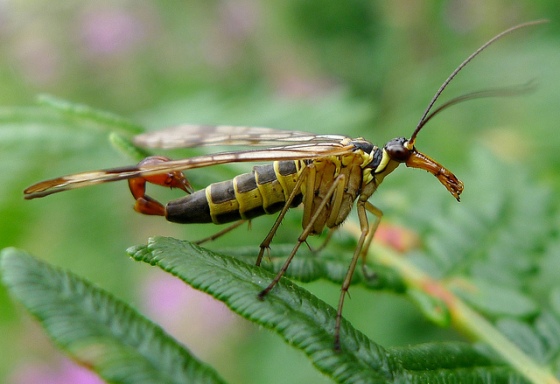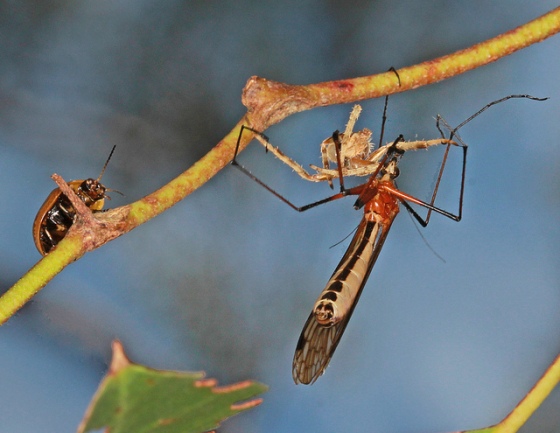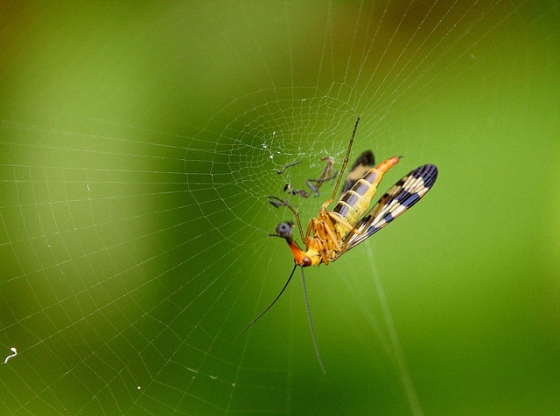Since the 1960’s, over 200,000 murders have remained unsolved: a shocking rate of 1 out of every 3 cases. An emerging field offers promising new solutions. Forensic entomology helps solve mysteries by examining the types of insects present at a crime scene and the evidence they leave behind on a body or the surrounding area. Insects can provide clues about time of death and location of death, as well as capture important DNA evidence. Previously, forensic entomologists relied heavily on blowflies for data, believing that these insects were the first on the crime scene. However, a new study from forensic entomologists at the Southeast Texas Applied Forensic Science Facility reveals that a different insect (Mecoptera) is actually the first visitor to a newly deceased corpse. This vital information shifts the focus for forensic entomologists and provides valuable information on time of death.
The insects, Mecoptera, are commonly known as hangingflies or scorpionflies. Despite these names, scorpionflies are not actually true flies. That group is Diptera, and it includes your common housefly and fruit flies. Scorpionflies received their name because they can fly and they have enlarged sexual organs on males that mimic scorpion tails. Despite the uncanny resemblance to scorpion tail structures, no members of Mecoptera sting or have venom. Mecoptera‘s other common name, the hangingflies, refers to the tendency of Mecoptera to hang under leaves in order to catch prey and to procreate.

A male Mecoptera, or scorpionfly. The enlarged organ at the end mirrors a scorpion’s tail. Photo by Gail Hampshire (Flickr). The female scorpionfly lacks this feature, as you can see in the cover photo of this post. Cover photo by Vlad Proklov (Flickr).
The long wings of scorpionflies are one of the defining features of the Order. Almost all members of Mecoptera have four membranous (slightly transparent, soft) wings all roughly equal in size attached to their long body. The head of a Mecoptera is also very distinct and often is described as horse-like. This head contains chewing mouthparts that are used to feed on small insects and decaying animal matter.

A comparison of the membranous wings of a scorpionfly (Order: Mecoptera) on the left to the hardened top wings of a beetle (Order: Coleptera) on the right. You can see that beetles also have membranous wings under their hardened wings. Photos by Walwyn and Gilles San Martin, respectively (Flickr). The beetle photo has been cropped from the original.

The “horse-like” long face of Mecoptera, with mandibular (chewing) mouthparts at the end. Photo by Colin Avison (Flickr).
One subset of Mecoptera, Bittacidae, uses their specialized hind legs to catch prey while hanging onto the underside of leaves with their front legs. These hangingflies are actually the only predatory insects worldwide that use their hind legs to capture food. Another subset, Panorpidae, takes a much more opportunistic approach and instead robs spider webs rather than finding and capturing food for themselves.

A Bittacidae hangingfly capturing prey using its hind legs, while hanging below a branch. Photo by Linda Rogan (Flickr).

A Panorpidae scorpionfly robs a spider web for food. Photo by Ferran Pestaña (Flickr).
Food is an important part of life for Mecoptera, because many members of the Order use food as a gift to potential mating partners. The bigger the food gift (called a nuptial gift), the longer the male can mate with the female as she eats. Some males use dead prey as a nuptial gift, while others use a large, delicious ball of saliva. While spit in our food may be an act of vengeance by an annoyed waiter or irritating little brother, to Mecoptera there is nothing more appetizing.
By: Kallin Lang
Feature Photo by: Vlad Proklov, Flickr

